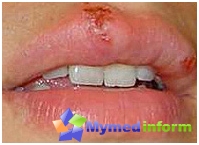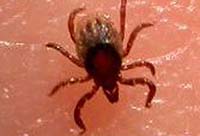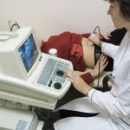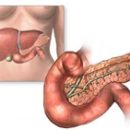Cleaning encephalitis is a viral infection affecting the central and peripheral nervous system. The incubation period of the tick-borne encephalitis is an average of 7-14 days, after which the damage to the nervous system occurs, which in a serious case can lead to paralysis and will end with a fatal outcome.
Content
Concept of tickle encephalitis
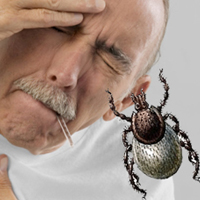 Tick-borne encephalitis (spring-summer encephalitis, taiga encephalitis) - viral infection, affecting the central and peripheral nervous system. Severe complications of acute infection can be completed with paralysis and fatal outcome.
Tick-borne encephalitis (spring-summer encephalitis, taiga encephalitis) - viral infection, affecting the central and peripheral nervous system. Severe complications of acute infection can be completed with paralysis and fatal outcome.
The main tank of the virus of tick-borne encephalitis in nature is its main carriers, ixodic ticks, the habitat area is located throughout the forest and forest-steppe temperate climatic zone of the Eurasian continent. For tick-borne encephalitis, a strict spring-summer seasonality began a disease associated with the seasonal activity of carriers.
Encephalite tick is not a type of tick, but a tick, infected with a tick-borne encephalitis virus. Tick-borne encephalitis transfer two types of ixodic ticks - Ixodes Persulcatus (taiga tick) of the habitat of which is located in the Asian and in a number of areas of the European part and Ixodes Ricinus (European Forest Tick) with habitat in the European part. The period of the greatest activity of the ticks falls on the spring and summer.
Human infection with virus tick-borne encephalitis occurs during blood circulation of virus ticks. Blood of female tick lasts many days, and in full saturation it increases in weight 80-120 times. The bloodsuit of males lasts usually for several hours and can remain unnoticed. The transfer of tick-borne encephalitis virus can occur in the first minutes of suction of a tick to a person. It is also possible to infection through digestive and gastrointestinal tracts when taking crude milk of goats and cows infected with tick-born encephalitis.
The main symptoms of tick-borne encephalitis
The incubation period of tick-borne encephalitis lasts on average 7-14 days with fluctuations from one day to 30 days. When infected through the milk, the incubation period of tick-borne encephalitis is 7-10 days. There are prescribing weakness in the limbs, neck muscles, numbness of the skin of the face and neck.
Manifestations of tick-borne encephalitis are diverse, the course of variable. The disease often begins acutely, with chills and increasing body temperature up to 38-40°WITH. Fever lasts from 2 to 10 days. There are general ailments, sharp headache, nausea and vomiting, drierness, fatigue, sleep disorders.
In the acute period, hyperemia (redness) of the skin of the face, neck and chest, oxide mucous membrane, injection of scler and conjunctiva. Worried pain in all body and limbs. Muscle pain is characterized, especially significant in muscle groups, in which paresis and paralysis are usually occurring. Sometimes they are preceded by numbness, paresthesia and other unpleasant feelings. From the moment of the beginning of the disease, the permanent of consciousness may occur, the strengthening of which can reach the degrees of coma. However, the disease often flows into the lungs, broken forms with a short fever.
The course of tick-borne encephalitis
Despite the diversity of manifestations of the acute period of tick-borne encephalitis, in each case, the leading disease syndrome can be distinguished. Based on this, as well as taking into account the severity and perseverance of neurological symptoms, five clinical forms of tick-borne encephalitis are distinguished:
- Feathery (Eludy)
- Meningheal
- Meningoencephalitic
- Poliomelitic
- Polyradiculoneuritical
The fever shape of tick-borne encephalitis is characterized by a favorable course with rapid recovery. Frequency duration - 3-5 days. The main signs of it are toxic-infectious manifestations - headache, weakness, nausea - with a weakly pronounced neurological symptoms.
Meningkeal form is the most frequent form of tick-borne encephalitis. Patients complain of a strong headache, increasing at the slightest movement of the head, dizziness, nausea, single or multiple vomiting, pain in the eyes, photophobia. They are sluggish and inhibit.
The meningoenefalitic shape of the tick-borne encephalitis is less common than meningeal. This shape of the tick-borne encephalitis is characterized by a more severe flow. It is often observed nonsense, hallucinations, psychomotor excitation with loss orientation in place and in time. Epileptic seizures may develop.
The polyomelitic shape of the tick-borne encephalitis is observed in almost a third of the patients. It is characterized by a long period (1-2 days), during which overall weakness and increased fatigue are noted. Suddenly, weakness can develop in any limb or the appearance of a feeling of numbness in it (later in these limbs often develop severe motor disorders).
The polyradiculoneuritic form of tick-borne encephalitis is characterized by the lesion of peripheral nerves and roots. Patients appear in pain along the nerve trunks, paresthesia (feeling «crawling geasses», tingling).
For emergency prevention of tick-borne encephalitis, if you cannot use antiquity immunoglobulin (the presence of contraindications, more than 96 hours have passed after the tick bite), doctors recommend the anaferon anti-fleeon. The drug increases the formation of interferon in the body and is allowed to use in children from 1 month. Anaferon is recommended to apply after a tick bite for 21 days. The drug can be appointed in a later dates (later than 96 hours from the moment of bite), but preferably earlier use. In addition, Anaferon can be prescribed and in parallel with the use of anti-anti-immunoglobulin.



